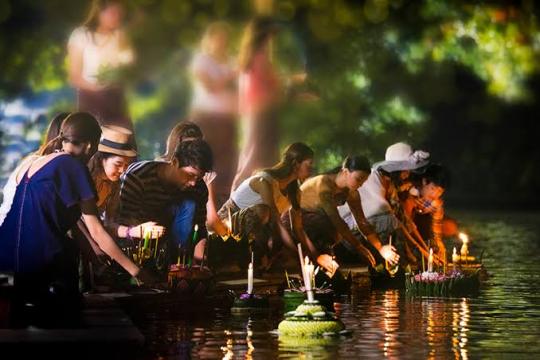Welcome to our blog, where a group of passionate teenagers come together to strive to share valuable information and insights about social issues and cultural differences. Our goal is to foster understanding, empathy, and promote positive change in our society. In this blog, we will delve into a wide range of social issues, including but not limited to racial inequality, gender disparities, discrimination, human rights, and cultural diversity. Our team of dedicated writers, who come from diverse backgrounds themselves, will offer unique perspectives and personal stories to provide a holistic understanding of these complex topics. Joining us as we explore social issues and cultural differences with compassion, open-mindedness, and a commitment to creating a better future for all.
Don't wanna be here? Send us removal request.
Text
WHAT'S IN THAILAND AND THEIR CULTURE ?
Do you want to explore around the world? In this series, we will delve deeper into the various aspects of Thai culture, exploring its rich history, traditional arts, religious practices, and everyday customs. We will uncover the beauty and uniqueness of Thailand, providing an insight into what makes this Southeast Asian country an enchanting destination for cultural exploration. Join us as we embark on an incredible journey to explore the vibrant and captivating culture of Thailand.

HISTORICAL BACKGROUND OF THAILAND
Thailand is a Southeast Asian country. It's known for tropical beaches, opulent royal palaces, ancient ruins and ornate temples displaying figures of Buddha. In Bangkok, the capital, an ultramodern cityscape rises next to quiet canalside communities and the iconic temples of Wat Arun, Wat Pho and the Emerald Buddha Temple (Wat Phra Kaew). Nearby beach resorts include bustling Pattaya and fashionable Hua Hin
It was predominantly an agricultural country until the second part of the twentieth century, as during the 1960s, an increasing number of people moved to Bangkok, the capital, and other cities.
LANGUAGE

Thai languages fall under Tai (a subfamily of Tai-Kadai tongues), Mon-Khmer (a subfamily of Austroasiatic languages), Austronesian, or Sino-Tibetan. Furthermore, English is used extensively in Thailand for business and many official functions. It is an obligatory school topic from the primary grades onward. However, only those who progress beyond those years, particularly those who attend elite schools, develop significant proficiency in the language.
VALUES AND NORMS
Thai values that you should know:
Thailand is known as "the land of smiles" because Thai people always appear to show a bright smile to avoid disagreement and "save face."
Throughout the country, the most important values that Thai people hold are 'respect', 'self-control' and a 'non-confrontational attitude'. It's beyond just stoicism. Losing face by showing anger or by telling a lie is a source of great shame for Thai people
Respect for parents, teachers, andother adults are required of children. The old must be treated with respect by the young people in high-profile positions in society, including monks, doctors, teachers, police and prominent public personalities, who are constantly revered.
Some of Thai Norms:
If a woman needs to pass something to monk, it is best to give it to a male to then pass forward or hold the object with a handkerchief/tissue. It is generally forbidden for Buddhist monks to come into physical contact with women.
The right hand is used to pass or receive items. Sometimes, both hands are used, but it is taboo to use only one left hand. Pointing at another person with one's index finger or feet is considered rude The soles of one's feet should never be pointed at another person. One should sit in a way that avoids this. Feet should also not be rested on tables or pillows that people sleep on The top of the head is considered to be the most important part of the human body. To touch someone on the top of their head, especially a baby or child, is rude and insensitive
CULTURE & TRADITIONS
Festivals: Thailand is known for its colorful festivals. Some of the most popular ones include Songkran, the Thai New Year celebration where people partake in water fights and visit temples, and Loy Krathong, the festival of lights where floating lanterns are released into rivers and skies.
Thai Boxing (Muay Thai): Muay Thai is a traditional combat sport that originated in Thailand. It is regarded as the national sport and deeply ingrained in Thai culture.
Traditional Clothing: The traditional Thai clothing includes the "chut thai" for women, consisting of a cylindrical skirt called "pha nung," and a fitted blouse called "chong kraben." For men, the traditional outfit is called "chong kraben," which consists of a wrap-around skirt.



RELIGIOUS BELIEFS

Buddhism is Thailand's most popular religion, with approximately 94% of the population practicing it. The Thai Constitution makes no mention of a state religion, but instead promotes Buddhism while ensuring religious freedom for all Thai citizens. Many other people, particularly from the Isan ethnic group, follow Tai folk religions. A sizable Muslim population, primarily composed of Thai Malays, lives in the southern regions. Thailand's official religions are Buddhism, Islam, Hinduism, Sikhism, and Christianity.
Thai customs and culture are exceptional in many ways. Families are incredibly important to Thai people. The elders are cherished and respected in Thai families. Their guidance is sought after, and their opinions are highly respected. Large families are also common in Thailand, where relatives frequently reside together. The link between Thai culture and religion is another distinctive feature. Last but not least, the Thai people are renowned for their warmth and hospitality. They are friendly and hospitable to tourists in their country and are eager to grin and laugh.
Exploring the culture of Thailand is an enthralling experience that takes you on a journey through ancient traditions, vibrant festivals, delicious cuisine, serene temples, and warm hospitality.
Overall, exploring the culture of Thailand is like stepping into a fascinating tapestry of tradition, spirituality, flavors, and smiles. From the bustling cities to the tranquil countryside, this diverse country offers an array of experiences that promise to leave a lasting impression and create memories of a lifetime.
0 notes
Text
In this blog, we will delve into a wide range of social issues, including but not limited to racial inequality, gender disparities, discrimination, human rights, and cultural diversity. Our team of dedicated researchers, will offer unique perspectives and personal stories to provide a holistic understanding of these complex topics.
We understand that cultural differences play a significant role in shaping our societies, and we aim to explore these differences with respect and appreciation. Through our blog posts, we will shed light on various cultural practices, traditions, and customs, as well as the challenges and opportunities that arise from embracing diversity.

Our blog will serve as a platform for education, awareness, and respectful dialogue. We will provide well-researched information, statistics, and real-life examples to help our readers gain a deeper understanding of these social issues and cultural differences.
We also invite our readers to engage with us and share their perspectives, experiences, and ideas. We believe that by coming together and learning from one another, we can break down barriers, dismantle stereotypes, and promote unity.
As we share insights and information, we hope to inspire action and empower our readers to become advocates for positive change in their own communities. We will provide resources, suggestions for further reading, and ways to get involved, encouraging our audience to actively contribute to building a more inclusive and equitable world.
Together, let's make a difference.
2 notes
·
View notes
